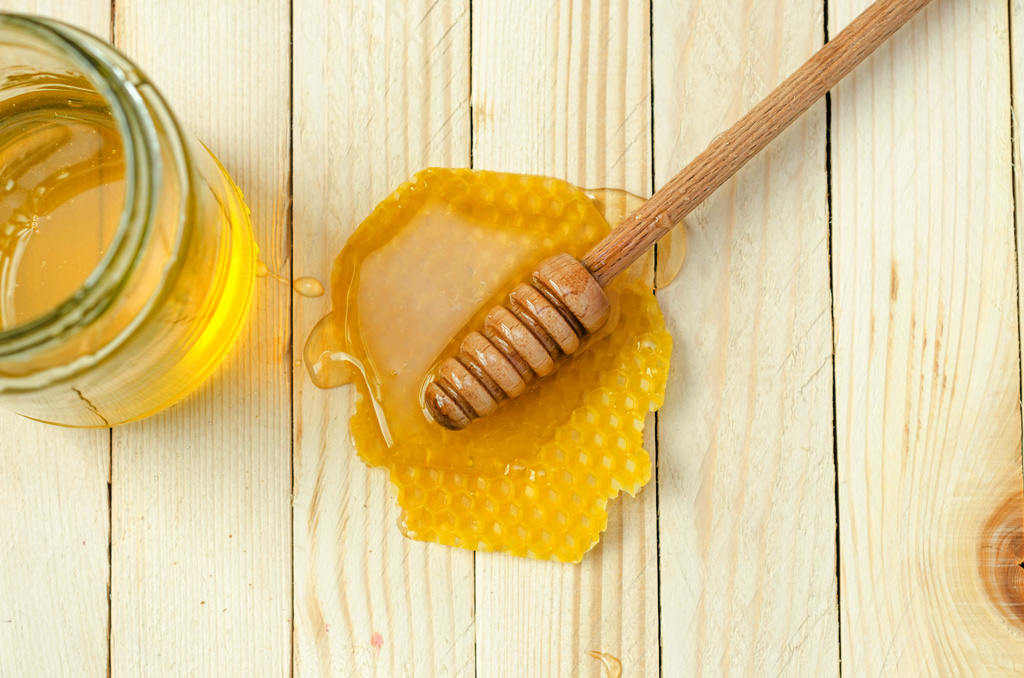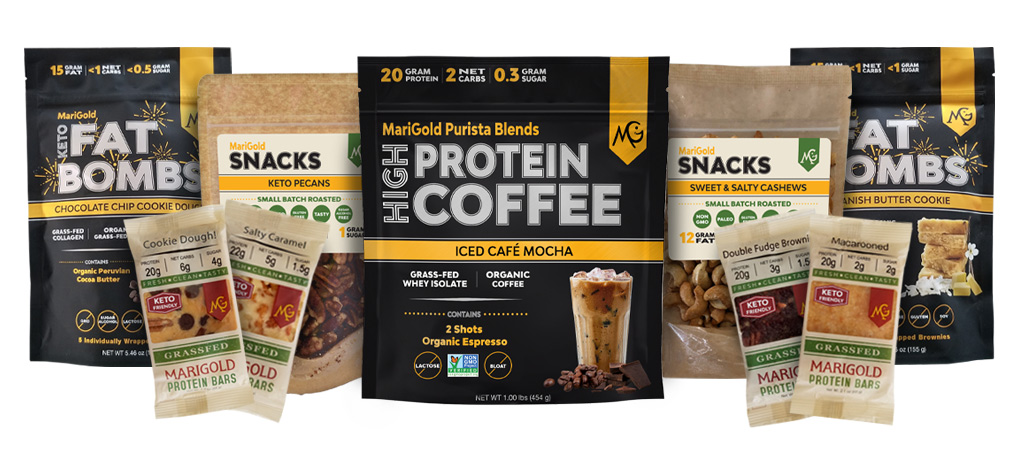Honey, maple syrup, stevia, date sugar, molasses, yacón syrup, coconut palm sugar — oh my! The natural sweetener section at your grocery store can feel like a sugar rush. By switching out the standard white stuff for an exotic alternative, not only do you get a major flavor upgrade, but you also can complement your active lifestyle that demands the best nutrient-rich fuel. Sweet!
“These closer-to-nature sweeteners come from bees, trees and fruit, and because they’re less processed than white sugar, most provide vitamins, minerals and antioxidants,” says Rebecca Scritchfield, RDN, a nutritionist in Washington, D.C. It doesn’t mean you can eat yourself into a sugar coma — moderation is still key when it comes to added sweeteners — but swapping in natural sweeteners can punch up everything from homemade protein bars to DIY salad dressings. So put down the nutrient-void processed white sugar and pick up these natural alternatives. Your workout and taste buds will thank you!
Honey
64 calories per tablespoon
Nutrient news: The darker the honey, the more flavor and antioxidants.
Raw deal: Raw honey doesn’t necessarily have more nutrients or antioxidants; it just hasn’t been heated or filtered.
Tip: If your honey jar has crystallized, put it in a bowl of hot water.
Good news: Studies show that honey can give endurance athletes a natural boost during intense exercise. “Endurance athletes need carbohydrates during exercise to maintain glycogen stores, and honey’s natural sugars are quickly and easily absorbed,” Scritchfield says. Honey also contains oligosaccharides, complex carbs that feed the good bacteria in the gut for better mineral absorption and boosted immunity. Although it has more calories than sugar, it’s sweeter and denser, so you’re likely to use less.
Sweet Ideas
“I love honey because it’s a truly natural sweetener with very minimal processing,” says Shauna Sever, author of Real Sweet (William Morrow Cookbooks, 2015).
- Add a teaspoon to your preworkout smoothie for energy.
- Saute steamed carrots with 1 tablespoon honey + 1 teaspoon apple cider vinegar until glazed (two to four minutes)
- Elevate icing: Beat together 1/3 cup raw or regular honey + ½ cup coconut oil + ½ cup cocoa powder + ½ teaspoon vanilla extract.
Stevia
0 calories per tablespoon
Buyer beware: Some brands (Truvia) mix stevia with sugar alcohols to bulk it up, which can cause stomach upset.
If you’re counting calories, meet your new BFF! Stevia is way sweeter than table sugar — like 200 times sweeter — but with zero calories (and no sugar crash!). But it’s not all good news: “It comes from highly purified extract of stevia called rebaudioside A, so it’s more processed than people think,” says Sharon Palmer, RDN, author of Plant-Powered for Life (The Experiment, 2014). The bitter, licoricey aftertaste also can be a turnoff, and because you use a lot less, it’s tough to substitute in baked goods.
Sweet Ideas
“Stevia tastes great in things like raw desserts or to sweeten smoothies because you’re just adding a few drops,” says Amy Chaplin, cookbook author of At Home in the Whole Food Kitchen (Roost Books, 2014).
- Add a few drops to sweeten oatmeal.
- DIY stevia lemonade: Mix 2 quarts of water + 1 cup fresh squeezed lemon juice + ½ teaspoon liquid stevia served over ice.
- Sweeten chia pudding: Combine 1 cup milk of choice + ¼ cup chia seeds + two to three drops liquid stevia, stir, cover and refrigerate 30 minutes or overnight.
Coconut Palm Sugar (aka Coconut Sugar)
45 calories per tablespoon
Shop smart: Don’t confuse coconut palm sugar with palm sugar, which comes from the sugar palm tree. Look for one ingredient: coconut nectar sugar or coconut palm sugar.
Made from the boiled, dehydrated sap of coconut flowers, this crash-free sweetener has a super-low glycemic index rating — 35 compared to 70 for regular sugar. “Since it’s unrefined, it retains nutrients, including iron, zinc, calcium and potassium, along with disease-fighting polyphenols,” Scritchfield says. It tastes like brown sugar and even dissolves in hot and cold liquids.
Sweet Ideas
“The most important thing to note is that it doesn’t taste anything like coconut,” says Sever, who loves it in banana bread.
- Stir into your coffee or chai latte.
- Sprinkle over baked apples or grilled peaches for a caramel coating.
- Use it to sweeten Thai soups or curries.
- Make your own vegan caramel sauce: Bring 1/3 cup coconut sugar + 2 tablespoons coconut oil + ½ cup full fat canned coconut milk to a boil, stirring constantly. Reduce heat until thickened.
Maple Syrup
52 calories per tablespoon
Nutrient news: The darker the maple syrup, the more flavor and antioxidants.
Tip: Real maple syrup (not the Aunt Jemima stuff) can boost recovery postworkout. “In addition to carbohydrates that can replenish glycogen stores after exercise, maple syrup contains manganese, zinc and potassium to replace minerals lost during exercise and replenish electrolytes,” Scritchfield says. Plus, it’s packed with polyphenols, plant-based compounds that may prevent disease. Stick to pure maple syrup as the only ingredient.
Sweet Ideas
- Add a teaspoon to sweeten iced coffee. (It melts into cold liquids!)
- Make maple balsamic vinaigrette: Whisk together equal parts pure maple syrup, balsamic vinegar and extra-virgin olive oil.
- Make your own sports drink: Add 1 teaspoon maple syrup + 2 tablespoons fresh lime or lemon juice to 1 cup water + ice.
Date Sugar
45 calories per tablespoon
Shop smart: Look for one ingredient: dehydrated dates or dried dates.
This unprocessed sweetener is less sweet than table sugar with a kick of caramel, and it delivers potassium, magnesium, selenium and copper. “Date sugar is also high in antioxidants, anti-agers that have been linked to disease prevention,” adds Jennifer Neily, MS, RDN, a registered dietitian in Dallas. Sticky note: It doesn’t dissolve when added to drinks or “melt” like brown sugar, plus it can be pricey (like $9 per pound).
Sweet Ideas
- Sprinkle date sugar onto Greek yogurt, oats or cereal for sweetness and texture.
- Use it as the sweet binder in homemade protein bars.
- Make raw brownie bites: Process 1 cup raw walnuts + ½ cup date sugar + ¼ cup raw cocoa powder + 1 tablespoon water until it forms a dough and roll into balls.
Yacón Syrup
20 calories per tablespoon
Easy off: Oil or spray your measuring cup first to make it easy for yacón syrup, molasses or honey to slide out.
Made from the root of the South American yacón plant, this fruity syrup has half the calories of sugar (woohoo!), and it’s even been linked to weight loss. In a study published in Clinical Nutrition, overweight women taking two doses a day lost 33 pounds in four months. The secret ingredient is fructooligosaccharides, a non-digestible fiber that can boost feelings of satiety. But don’t take this as a license to overindulge, Neily warns: “It’s only half as sweet as sugar, so you might end up using twice as much.”
Downside: Expect to pay a pretty price, like $15 for an 8-ounce jar.
Sweet Ideas
“Yacón is dark like molasses but much milder,” says Chaplin, who uses it to sweeten homemade energy bars.
- Drizzle over yogurt, oatmeal and even roasted squash.
- PB&Y: Top peanut butter toast with a drizzle of yacón syrup.
- DIY yacón Dijon dressing: Whisk 2 tablespoons yacón syrup + 2 tablespoons extra-virgin olive oil + 1 tablespoon Dijon mustard + 1 tablespoon apple cider vinegar.
Molasses
58 calories per tablespoon
Best bet: Blackstrap molasses is the most flavorful and nutrient-dense sweetener. It works best in savory dishes like baked beans and pulled pork.
Molasses — the dark, sticky syrup left behind after the sugar has been boiled out of cane and beet juices — has almost double the calcium of milk, more iron than flank steak, four times more potassium than a banana and the highest antioxidant levels of the bunch. Yes, it’s thick, messy and bitter, but the intense flavor is perfect in ginger cookies and spice cakes.
Sweet Ideas
- Drizzle into baked beans or chili.
- Stir a teaspoon into warm milk.
- Use blackstrap molasses to sweeten your homemade barbecue sauce and jerk chicken rub.
⚠️ More Than Meets The Eye ⚠️
Some bittersweet truths about three so-called “healthy” sweeteners:
Turbinado
Minus: Also known as Sugar in the Raw, it isn’t “raw” at all and nutritionally barely differs from table sugar.
Plus: The coarse crystals add a crunchy topper to cookies and scones.
Agave Syrup
Minus: It’s higher in fructose than high-fructose corn syrup, which studies have linked to obesity and diabetes. No wonder Dr. Oz broke up with it.
Plus: It gets points for versatility and for being low on the glycemic scale.
Brown Sugar
Minus: More processed than white sugar, most brown sugar is just white sugar with molasses added.
Plus: Adds moistness to baked goods.
Written by Allison Young for Oxygen Magazine and legally licensed through the Matcha publisher network. Please direct all licensing questions to legal@getmatcha.com.
Featured image provided by Oxygen Magazine
The Low Sugar Lowdown on MariGold
At MariGold, all our products are low sugar and designed to treat your body well.
Many of our bars have just a small touch of all natural sweeteners that have been in use for 1000’s of years. We keep things real instead of relying on sugar alcohols such as erythritol (from GMO crops) and Sucralose.
The natural sweeteners we use include Organic Stevia and Organic Maple Sugar along with these additional sweeteners with healthy benefits:
- Non-GMO Chicory Root Fiber – We use Chicory Root Fiber that has been water extracted from plants grown by local farmers in The Netherlands. This pre-biotic, soluble dietary fiber has a slightly sweet taste, with a glycemic index of 20. Chicory root fiber is an excellent source of fiber.
- Organic Coconut Nectar – We use non-GMO coconut nectar. This nectar, which comes from the flowers of coconut palm trees is minimally processed and nutrient dense.
This nectar is certified to have a glycemic index of 31. - Non-GMO Allulose – Allulose is considered a rare sugar, which is basically a sugar that can be found in nature in small quantities. It can be found naturally in fruits like raisins, figs, and jackfruit. Although it’s about 70% as sweet as the sugar you know and love (but try to stay away from), allulose tastes, feels and cooks just like regular sugar.But, unlike regular sugar, the way it’s processed by the human body makes it an optimal choice for many people looking to live a healthier lifestyle. You can learn more about allulose here.







